
For this edition of Classic Steel, we are going to take a look back at Yamaha’s 1987 YZ125.
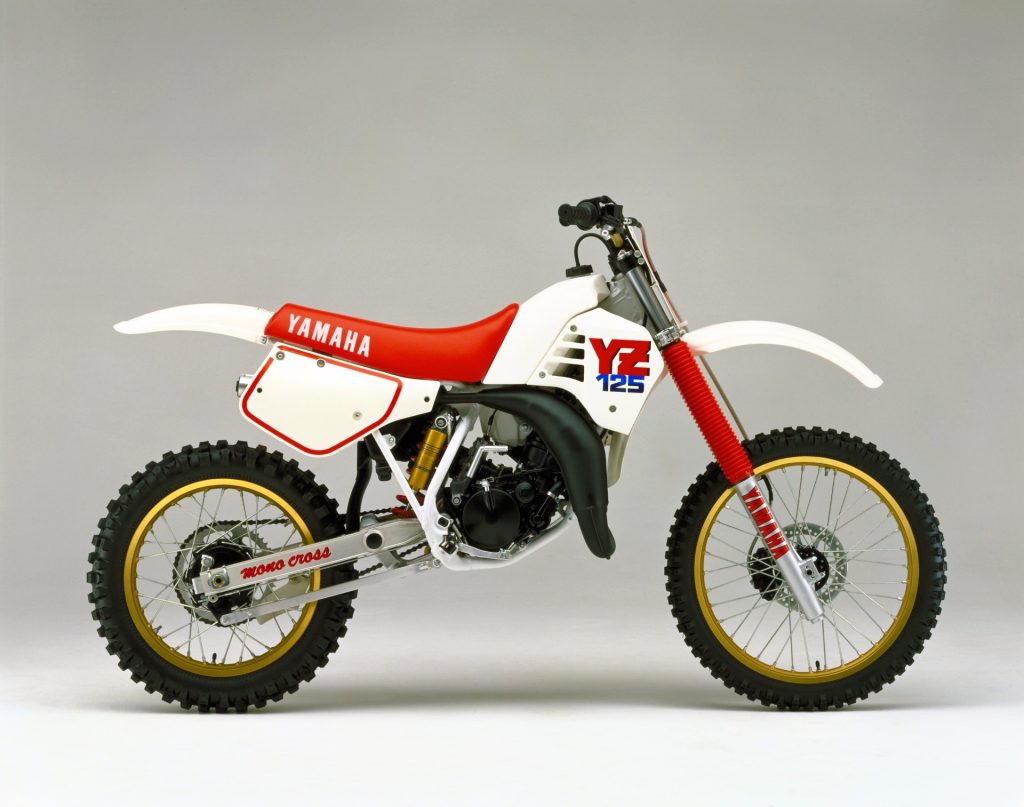 Visually very similar to the 1986 YZ125, the ’87 version featured beefed-up power and cleaner styling. Photo Credit: Yamaha
Visually very similar to the 1986 YZ125, the ’87 version featured beefed-up power and cleaner styling. Photo Credit: Yamaha
The early 1980s were a tough time to be a Yamaha rider in the 125 class. Early successes to start the decade were followed up by a string of ultra-disappointing eighth-liter offerings. The low point of this run of duds was the 1984 and 1985 YZ125s. These two machines were pretty to look at, but utterly lacking in the horsepower needed to run with their rivals. Narrow powerbands, mediocre handling, and subpar suspension action relegated these “Yamadogs” to the bottom of the heap in the yearly 125 standings.
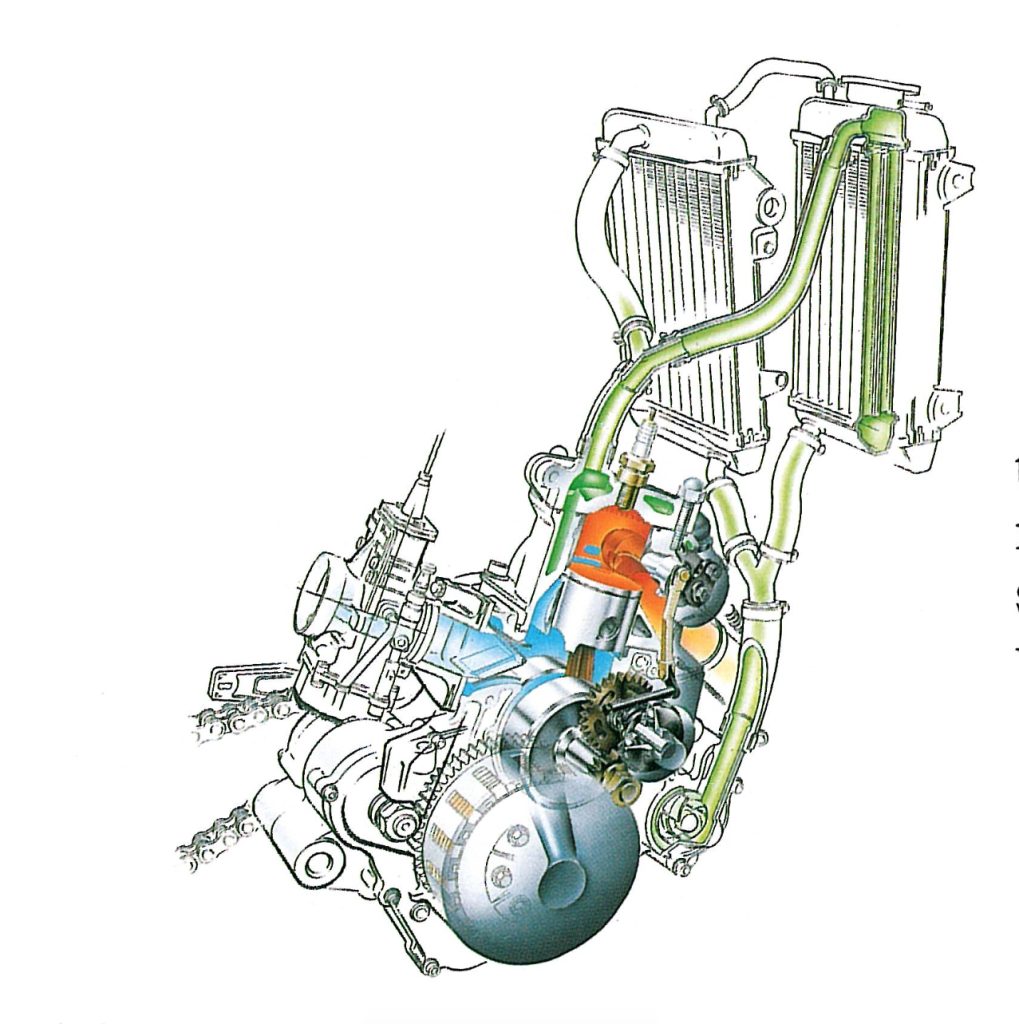 Yamaha made extensive changes in 1987 aimed at broadening the power and reducing the bog from their 123cc mill. A new intake reduced restriction while an all-new cylinder and YPVS valve improved fuel and exhaust flow. Photo Credit: Yamaha
Yamaha made extensive changes in 1987 aimed at broadening the power and reducing the bog from their 123cc mill. A new intake reduced restriction while an all-new cylinder and YPVS valve improved fuel and exhaust flow. Photo Credit: Yamaha
In 1986, Yamaha finally turned around its 125 fortunes by completely redesigning its YZ125 platform. All-new from the ground up, the ’86 YZ featured slimmed-down ergonomics, restyled bodywork, Öhlins-inspired suspension, and a powerful new case-reed motor. The new motor was head-and-shoulders faster than the old underpowered mill and rocketed the YZ back into 125 contention. Riders loved the ’86 YZ’s slim layout, light feel, and hard-hitting burst motor, but its middling suspension action, cranky clutch, notchy shifting, and one-dimensional power profile held it out of the top spot in most rider’s opinions.
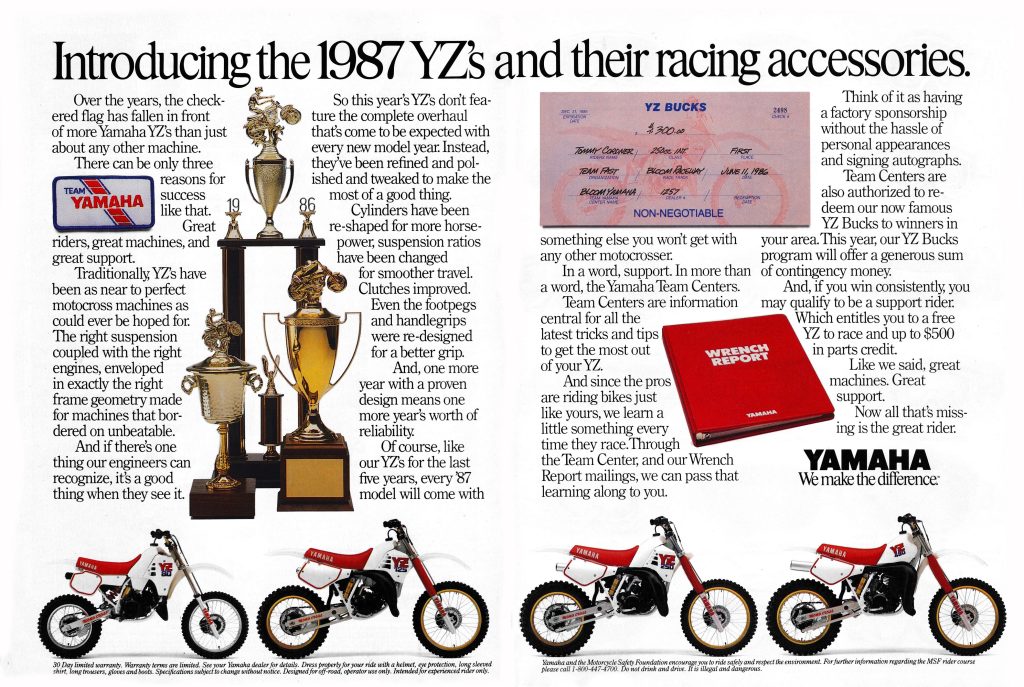 YZ Bucks contingency money was a major draw to race one of the YZs in 1987. Photo Credit: Yamaha
YZ Bucks contingency money was a major draw to race one of the YZs in 1987. Photo Credit: Yamaha
Coming into 1987, Yamaha knew they had a solid base but their 125 needed a dose of refinement to compete with Honda’s omnipotent CR125R. The little Honda offered broader power, smoother shifting, and better-sorted suspension than Yamaha’s white and red firecracker. With this in mind, Yamaha dialed up an extensive list of updates aimed at broadening power, increasing suspension comfort, upping reliability, and improving drivetrain performance.
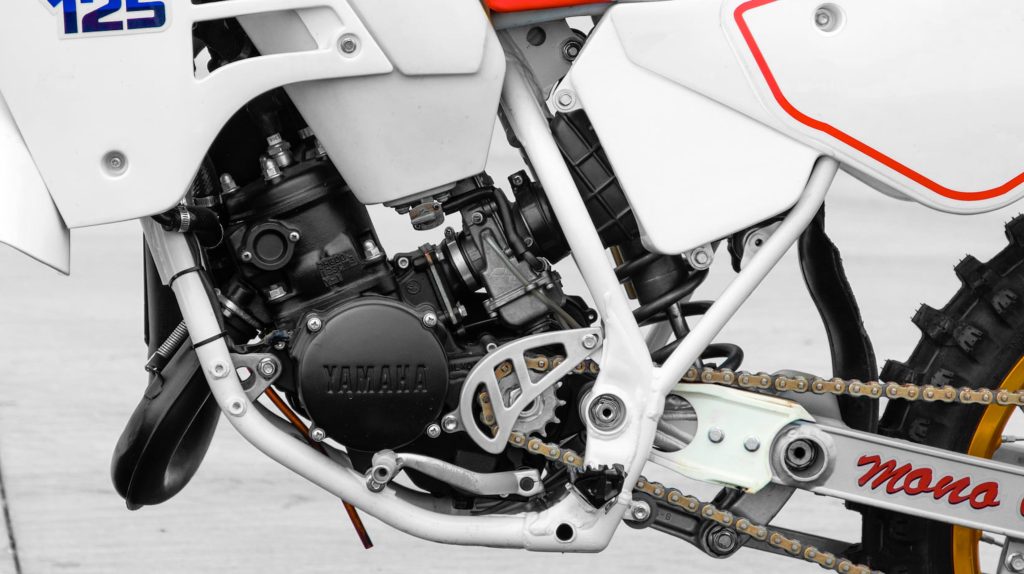 An all-new ignition for 1987 refined spark timing, repositioned the rotor weights, and increased inertia to help reduce the bogging suffered in 1986. Photo Credit: Mecum
An all-new ignition for 1987 refined spark timing, repositioned the rotor weights, and increased inertia to help reduce the bogging suffered in 1986. Photo Credit: Mecum
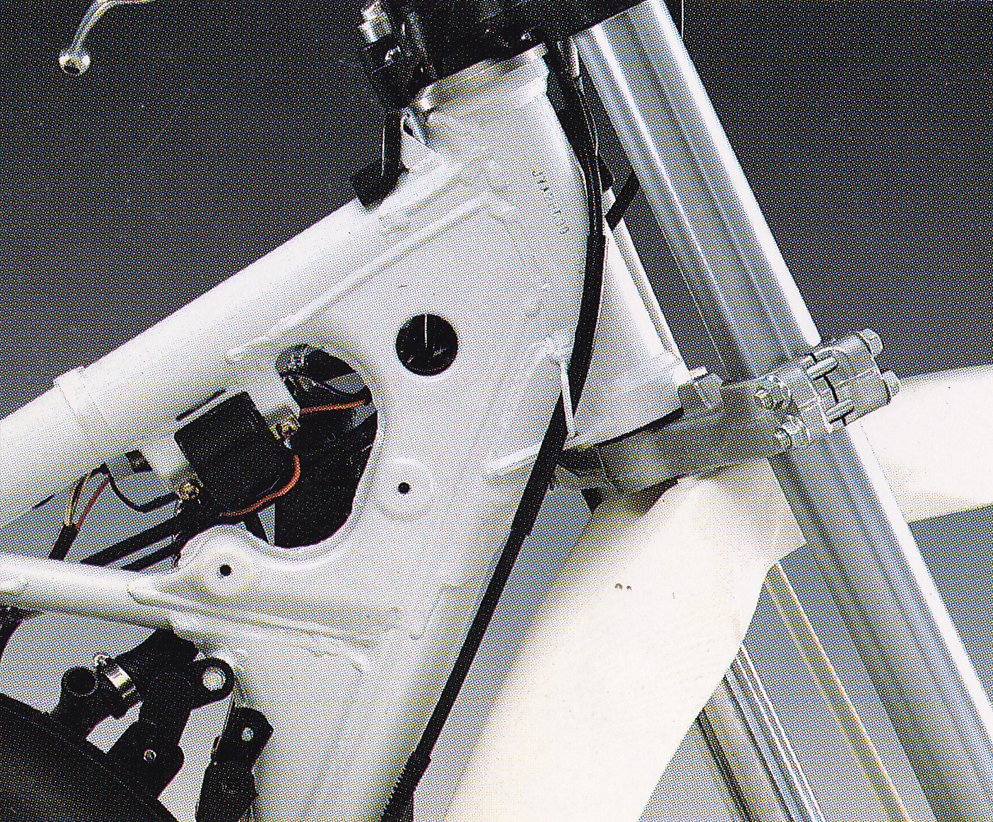 Frame changes for 1987 were limited to revised welding techniques to increase strength and a new lightweight alloy steering stem.
Frame changes for 1987 were limited to revised welding techniques to increase strength and a new lightweight alloy steering stem.
Visually, the 1987 YZ125 was virtually identical to the 1986 machine. All-new the previous year, the YZ’s bodywork was the slimmest in the class and well-liked for its good looks and comfortable riding position. The “works style” drop tank carried the fuel very low on the chassis and the side panels and seat were comfortable and unobtrusive. For 1987, the only visual changes were a return of boots for the forks, a switch from red to white for the radiator covers and frame, and a set of very bold new “YZ” graphics on the shrouds. Aside from the color swap, all of the YZ125’s bodywork was unchanged from 1986.
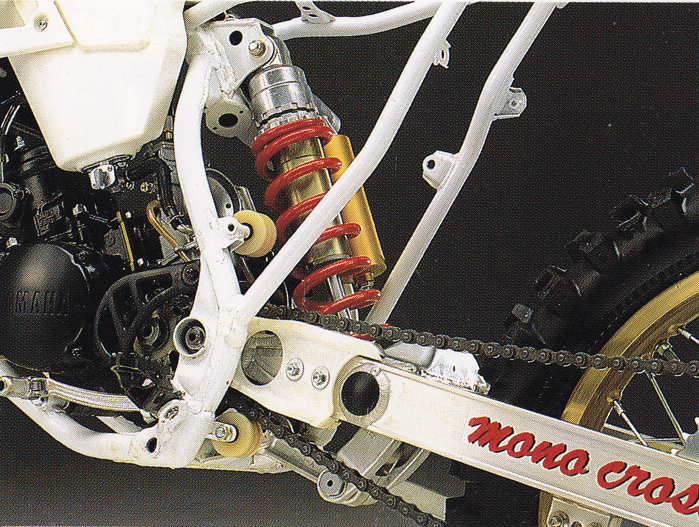 An all-new linkage for 1987 featured a more progressive rising rate curve while a revamped shock offered softer low-speed compression and harder high-speed compression settings. The addition of an upper chain roller prevented the chain from chewing on the frame as it had done in 1986. Photo Credit: Yamaha
An all-new linkage for 1987 featured a more progressive rising rate curve while a revamped shock offered softer low-speed compression and harder high-speed compression settings. The addition of an upper chain roller prevented the chain from chewing on the frame as it had done in 1986. Photo Credit: Yamaha
Like the bodywork, the chassis was largely a carryover from 1986. The rake, trail, and wheelbase remained unchanged with the only significant frame changes being a new welding process that Yamaha claimed would reduce chassis flex and the addition of an upper chain roller to prevent the chain from contacting the frame under full compression. As a side benefit, the upper roller was also said to improve rear suspension performance by using the tension of the chain to speed up the shock’s rebound on supercross-style obstacles. Redesigned footpegs for 1987 offered increased strength and a new steering stem reduced weight by moving to aluminum. An all-new front master cylinder repositioned the hose mount from below to the front to prevent contact with the rider’s knee and moved the sight glass to the rear to lessen the chance of roost causing damage. In the rear, the YZ stayed a step behind the competition by continuing to employ a drum for the braking duties. In 1987, both the Honda CR125R and Kawasaki KX125 featured powerful discs in the rear that offered stronger and more consistent braking performance. While the drum was old technology, new seven-millimeter wider brake shoes for ’87 looked to beef up its performance. All-new wheels for ’87 were lighter and stronger with tapered spoke nipples that Yamaha claimed were lighter while being just as strong as the old design.
 Kayaba’s all-new Variable Damping (VD) forks featured a special spring in the damper assembly designed to increase the fork’s resistance to bottoming while still allowing maximum compliance on smaller impacts. Photo Credit: Yamaha
Kayaba’s all-new Variable Damping (VD) forks featured a special spring in the damper assembly designed to increase the fork’s resistance to bottoming while still allowing maximum compliance on smaller impacts. Photo Credit: Yamaha
For 1987, the Monocross rear linkage was revamped to provide a more progressive curve and all bearings were upgraded to needle bearings for smoother and more consistent action. The basic design of the swingarm remained unchanged aside from some small tweaks required to accommodate the new linkage. Paired with the linkage was a revamped shock that retained its Öhlins roots and Yamaha’s slightly controversial Brake Actuated Suspension System (BASS). In use since 1985, the BASS was designed to improve suspension action under braking by reducing the shock’s compression damping once the brake pedal was applied. While sound in theory, the performance of the BASS had never seemed to live up to its hype and many riders found their YZs performed better with its mechanism disabled. Regardless of rider skepticism, the BASS-enabled Kayaba was back in 1987 with revamped valving designed to provide better tracking under acceleration and less kicking under deceleration. As in 1986, the KYB rear damper offered 12.4 inches of travel with 28 compression and 25 selectable settings for rebound control.
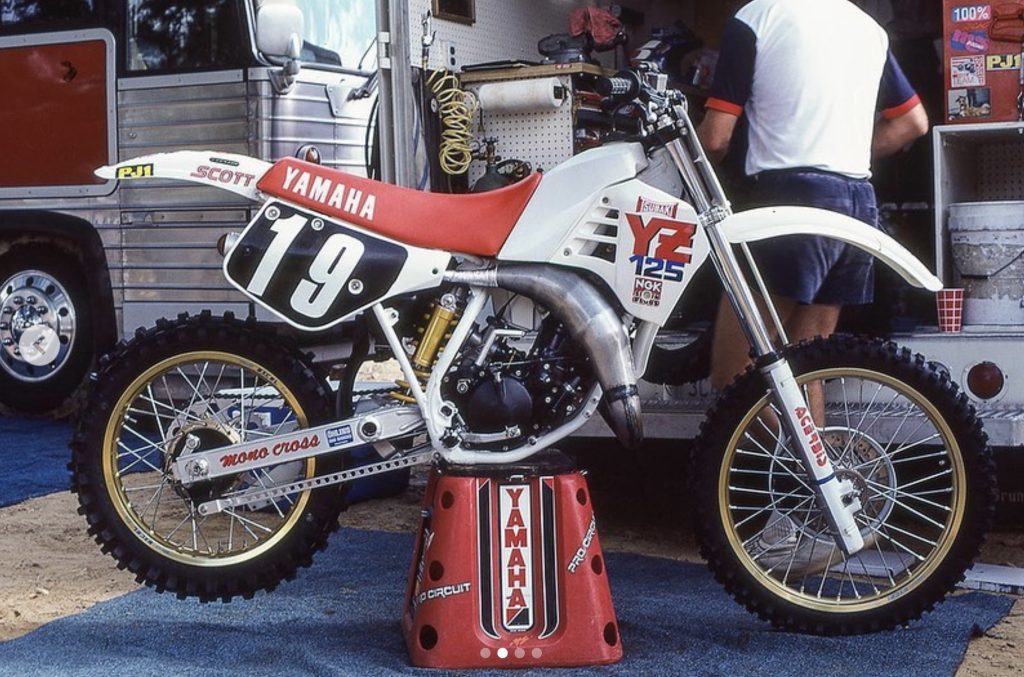 Australia’s Jeff Leisk was Yamaha’s top gun on the YZ125 in 1987. While Leisk would fail to card a victory on the YZ in 1987, his second place at Red Bud and third at San Antonio showed that the Yamaha had what took to run at the front. Photo Credit: Naoyuki Shibata
Australia’s Jeff Leisk was Yamaha’s top gun on the YZ125 in 1987. While Leisk would fail to card a victory on the YZ in 1987, his second place at Red Bud and third at San Antonio showed that the Yamaha had what took to run at the front. Photo Credit: Naoyuki Shibata
Up front, the 1987 YZ125 featured a brand-new set of 43mm Kayaba forks. In 1986, the YZ125 offered a very mediocre set of front forks, but none of its competitors seemed to do much better. Of the Big Four, the RM’s were the best, but none of them were on the same level as the amazing Showa cartridge units found on the CR250R and CR500R. For 1987, the fork competition in the 125 class was set to get much tougher with Honda and Suzuki both bringing cartridge dampers to their eighth-liter offerings. In Yamaha’s case, the cartridge system was thought to be too costly so they went with a simpler design they claimed would offer the same benefits with lower cost and reduced complexity. The new Variable Damper (VP) system relied on an innovative “sensor” spring to monitor fork travel and speed and adjust the damping as needed. Yamaha claimed the new VD damping system would allow the fork damping to feel light and smooth on small chop while also providing increased damping force when larger obstacles were encountered. Internally, a hard alumite coating was added to the components to reduce wear, and externally, a set of fork boots beefed up protection for the upper tubes and seals. Overall travel remained at 12.0 inches with 18 adjustable settings available for compression control. As in 1986, rebound damping was not externally adjustable.
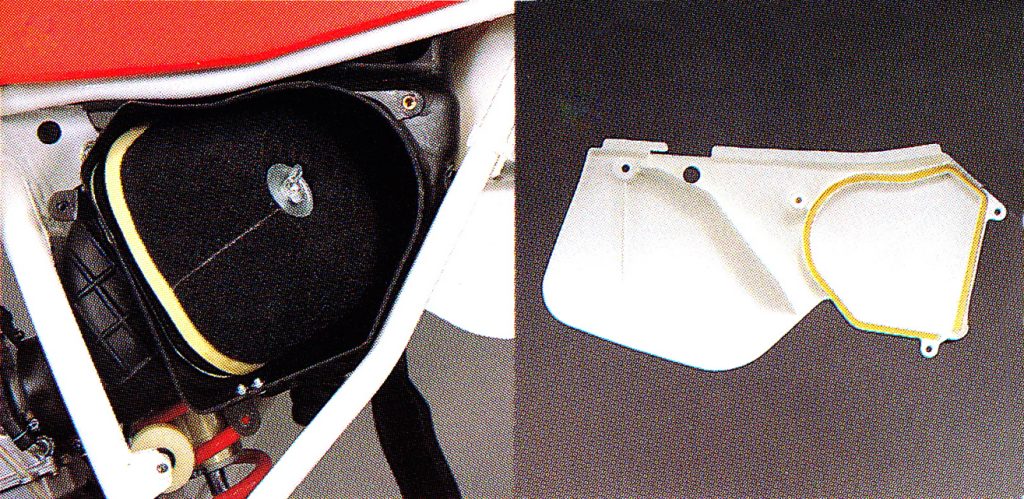 One of the keys to the YZ125’s improved power in 1987 was its enlarged airbox and larger air filter sourced from the deep-breathing YZ490. Photo Credit: Yamaha
One of the keys to the YZ125’s improved power in 1987 was its enlarged airbox and larger air filter sourced from the deep-breathing YZ490. Photo Credit: Yamaha
Aside from the forks, the most dramatic changes made on the YZ125 in 1987 were on the motor front. In 1986, Yamaha moved to an all-new case-reed design that finally brought the Why-Zed out of the 125-horsepower doghouse. The redesigned 123cc mill pumped out the most power in the class on the Kerker dyno and rocketed the YZ from afterthought to contender. While the motor was quite fast, its powerband was also quite narrow, with a massive hit that delivered all of its ponies over a short spread in the midrange. There was not a lot of grunt down low or revs on top, but when it lit the fuse, it was time to hold on.
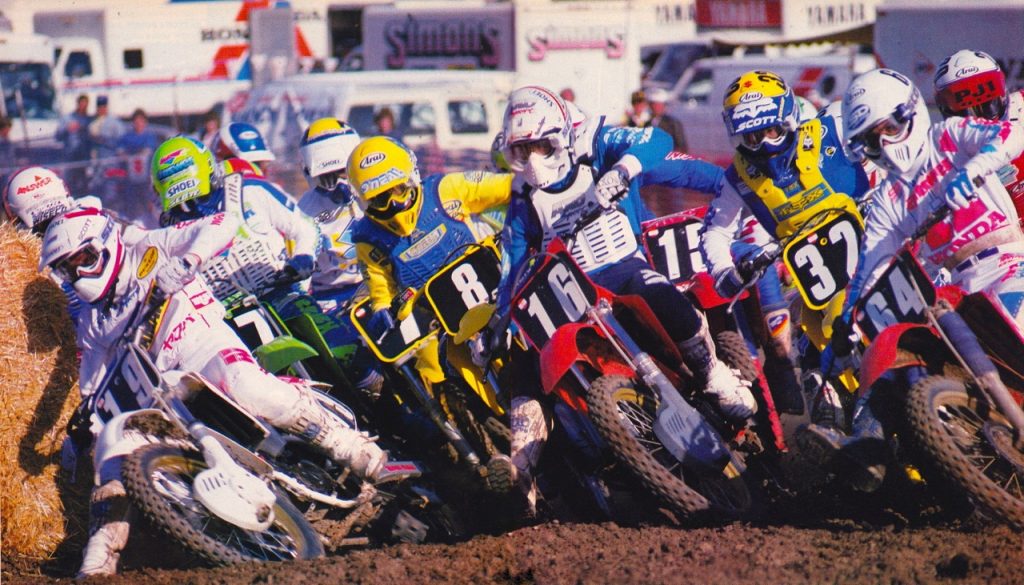 The YZ’s power was not the broadest in the class but in the right hands it had what it took to rip holeshots. Photo Credit: Motocross Action
The YZ’s power was not the broadest in the class but in the right hands it had what it took to rip holeshots. Photo Credit: Motocross Action
 The YZ was no shredder, but its handling was sure and capable under most circumstances. The only real complaint riders voiced with the YZ’s handling was its propensity to wheelie excessively on the exit of turns. Photo Credit: Yamaha
The YZ was no shredder, but its handling was sure and capable under most circumstances. The only real complaint riders voiced with the YZ’s handling was its propensity to wheelie excessively on the exit of turns. Photo Credit: Yamaha
Further exacerbating the motor’s narrow power spread was its notchy transmission and proclivity to bog unexpectedly. When landing from jumps or suddenly whacking the throttle open, the YZ would often bog badly, leading to unfortunate consequences. Shifting under power without backing off the throttle and using the clutch was virtually impossible as well and this made it even more difficult to navigate the YZ’s tricky power profile.
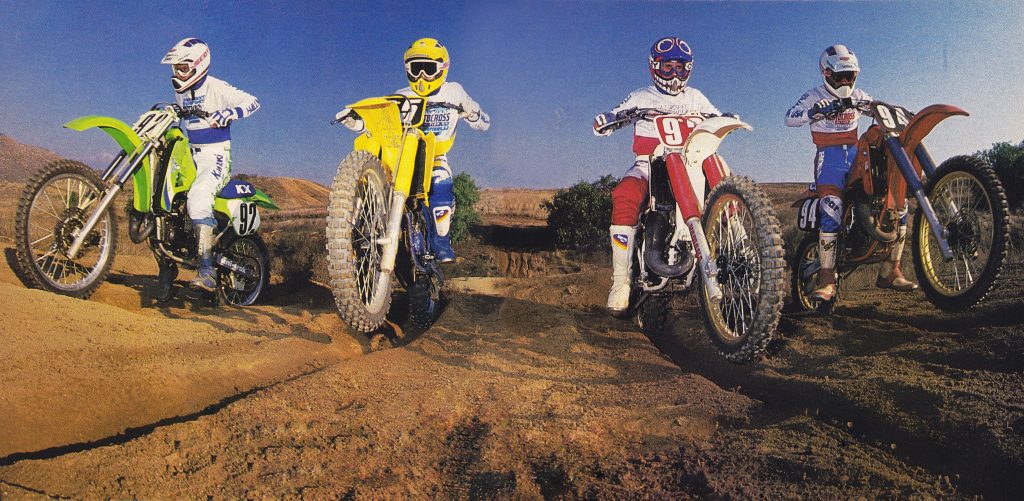 In 1987, the 125 division offered one of the most competitive lineups in years. While the Honda was regarded as the best overall stock machine, the Suzuki’s excellent suspension, the Kawasaki’s broad power, and the Yamaha’s “right now” bark all had their fans in the 125 ranks. Photo Credit: Motocross Action
In 1987, the 125 division offered one of the most competitive lineups in years. While the Honda was regarded as the best overall stock machine, the Suzuki’s excellent suspension, the Kawasaki’s broad power, and the Yamaha’s “right now” bark all had their fans in the 125 ranks. Photo Credit: Motocross Action
With this in mind, Yamaha’s motor goals for 1987 were to broaden the YZ’s powerband, improve the performance of its clutch and transmission, and exorcise its unpredictable bog. To do this, Yamaha’s engineers dialed up an extensive list of updates for their 123cc mill. First up was an all-new cylinder which featured revised porting and a revamped shape for the YPVS (Yamaha Power Valve System) drum. The lower cases were redesigned to shorten the intake tract and provide improved intake flow around the transfer ports and the crankcase oil passages were massaged to improve lubrication. Both bore and stroke remained unchanged, but a new crank featured redesigned weighting to reduce vibration and improve motor response. An all-new ignition was spec’d with an external rotor that was designed to reduce bogging by moving the weights farther from the crankshaft’s centerline to increase the “moment of inertia.” The new ignition also featured more accurate spark control through the use of an upgraded spark advance controller.
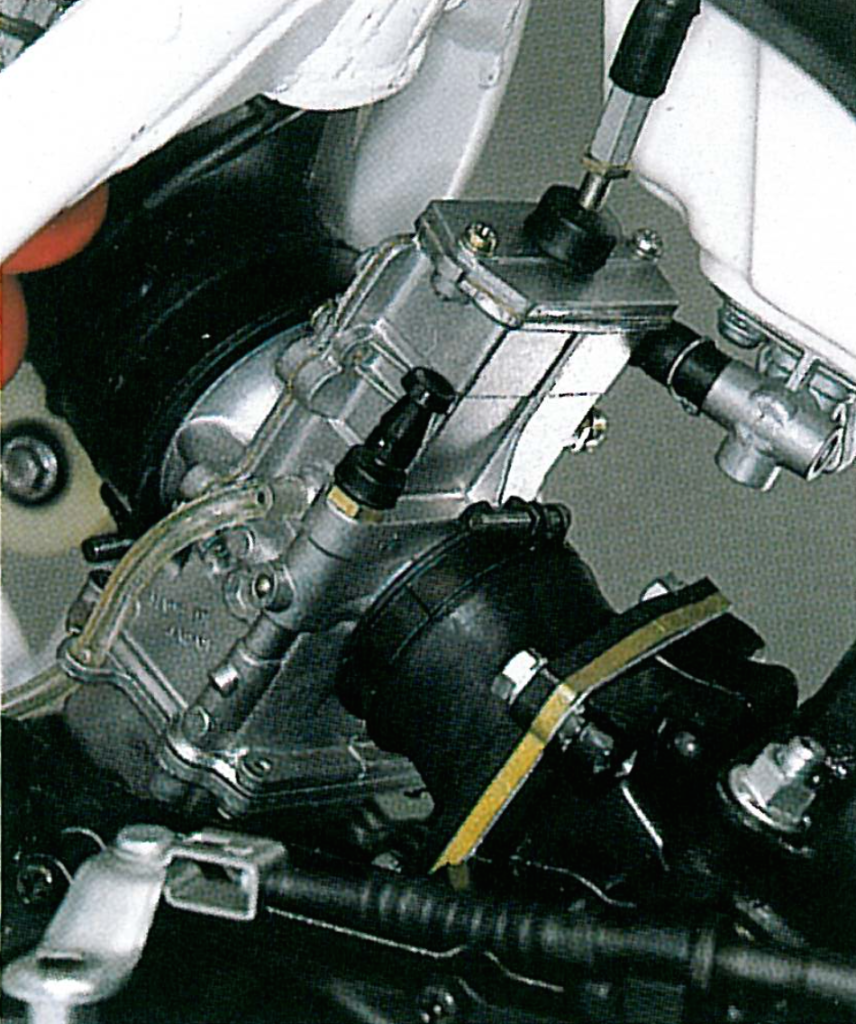 Bogging was a major issue with the 1986 YZ125 so Yamaha made several changes aimed at alleviating this annoying and potentially dangerous trait. In addition to the redesigned intake tract, freer-flowing filter, and heavier ignition, an all-new carburetor was added with redesigned floats and a larger baffle to prevent fuel starvation under high loads. Photo Credit: Yamaha
Bogging was a major issue with the 1986 YZ125 so Yamaha made several changes aimed at alleviating this annoying and potentially dangerous trait. In addition to the redesigned intake tract, freer-flowing filter, and heavier ignition, an all-new carburetor was added with redesigned floats and a larger baffle to prevent fuel starvation under high loads. Photo Credit: Yamaha
Further improving response and reducing the motor’s propensity to bog was a revamped 34mm TM34SS “flat-slide” Mikuni carburetor. This new mixer maintained the same size as the 1986 version but featured several updates aimed at improving performance. Internally, the new carburetor featured redesigned floats to reduce fuel starvation under heavy loads and a larger baffle plate to decrease fuel sloshing for improved response. This combined with a larger and freer-flowing airbox was all designed to take the hesitation out of the YZ repertoire. Finishing off the top-end changes was a new exhaust with a redesigned shape, improved sealing, and a new silencer, which featured easier maintenance.
 An all-new silencer for 1987 was quieter, had better sealing, and was more easily rebuildable. Photo Credit: Yamaha
An all-new silencer for 1987 was quieter, had better sealing, and was more easily rebuildable. Photo Credit: Yamaha
Helping the YZ put its power to the ground was an all-new transmission with wider ratios designed to work with the ’87s broader power curve. First through sixth gear were all taller than 1986 with the machine maintaining the same 13/50 final drive as the year before. In addition to offering new ratios, all the gears were increased in width to improve reliability and reshaped slightly for a smoother engagement. Clutch performance was upgraded through the use of a new two-piece clutch actuation arm that provided more even pressure to the pressure plate and the addition of an oil channel to deliver oil directly to the clutch’s main shaft.
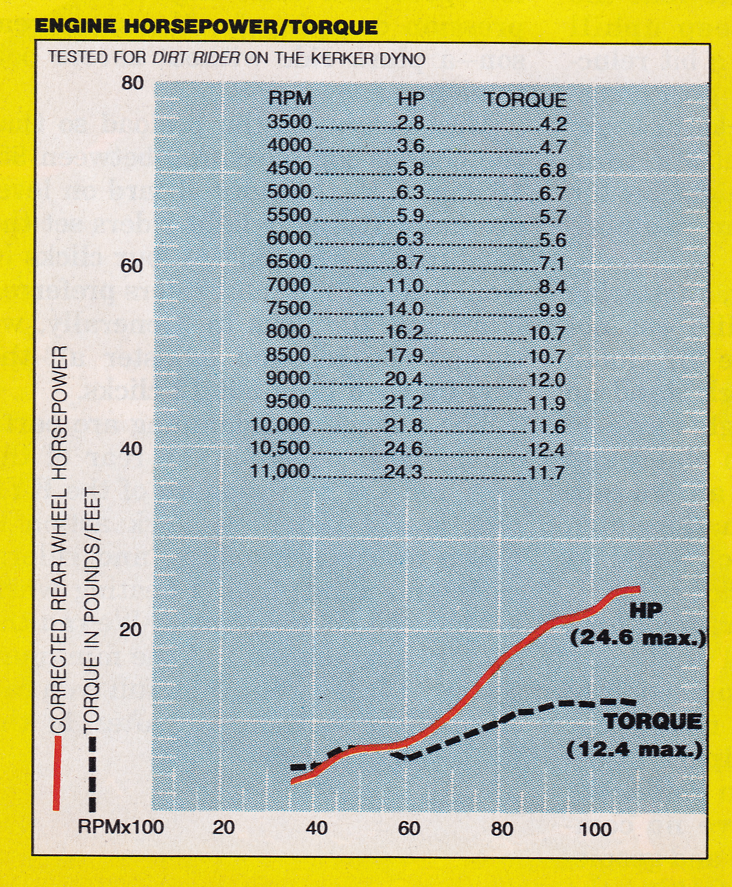 On the dyno the 1987 version of the YZ powerplant pumped out less peak horsepower and torque than the year before but on the track the new motor was superior. Photo Credit: Dirt Rider
On the dyno the 1987 version of the YZ powerplant pumped out less peak horsepower and torque than the year before but on the track the new motor was superior. Photo Credit: Dirt Rider
On the track, the 1987 YZ125 offered an improved but not substantially different riding experience than the year before. Of all the changes made, the most notable was the increased low-end power the revamped motor provided. The updated motor exploded off the bottom with a rush of torque that was more akin to Yamaha’s IT200 enduro machine than a typical 125 motocrosser. There was tons of grunt on tap and that was paired with the same potent midrange power that riders had enjoyed in 1986. Top-end pull remained non-existent, however, so the bike needed to be shifted early rather than revved to make the most of its strong low-to-mid powerband. The motor and carburetor tweaks alleviated all of the old engine’s bogging issues and the new mill was easily the most responsive 125 in the class. Throttle input equaled immediate forward motion and some novices even thought the motor was a bit too responsive down low. Its low-to-mid powerband was snappy and very fast, but you needed to be quick on the shifter to avoid running out of steam as it pulled past the midrange. If you revved it out too far, then the little YZ put out the anchor like you sucked a squirrel into the airboot. Grabbing the next gear before you hit that hard power drop-off was the only way to keep the YZ jamming.
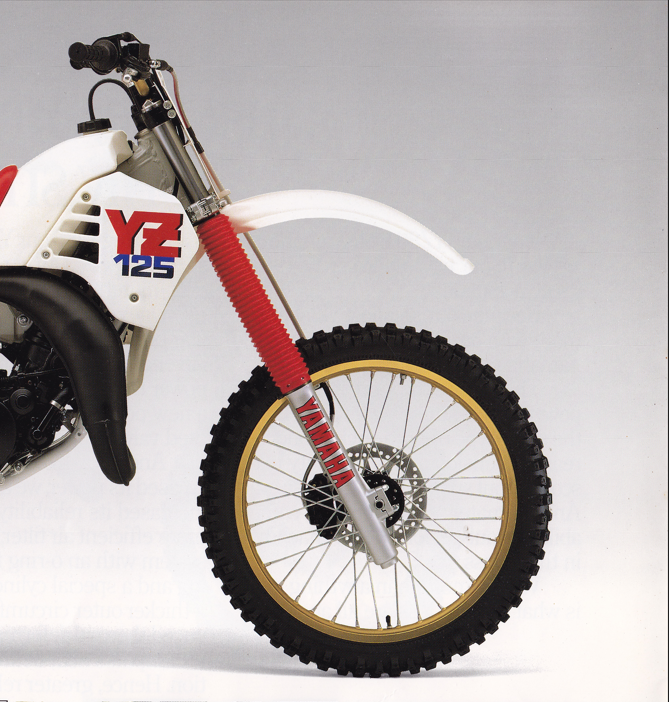 Yamaha’s decision to not keep up with the cartridge crowd backfired in 1987. Kayaba’s new Variable Damper forks were innovative in design, but grim in action. Bottoming resistance was good, but they were incredibly harsh in action on everything else. They were easily the worst stock forks in the ’87 125 class. Photo Credit: Yamaha
Yamaha’s decision to not keep up with the cartridge crowd backfired in 1987. Kayaba’s new Variable Damper forks were innovative in design, but grim in action. Bottoming resistance was good, but they were incredibly harsh in action on everything else. They were easily the worst stock forks in the ’87 125 class. Photo Credit: Yamaha
Unfortunately, however, finding that next gear was often a bit of a challenge. The changes to the clutch for 1987 resulted in a much-improved unit but the transmission remained a real nuisance to use under power. The clutch no longer squeaked and chattered when hot and took abuse without pulsing and fading. The transmission, however, remained incredibly stubborn. The shifting feel was extremely notchy and backing off the throttle and feeding in some clutch were the only ways to assure a positive shift. Powershifting was nearly impossible, and the only real solution was to pony up the $100 for Race Tech’s Rube Goldberg-looking aftermarket shifter. This device added a linkage that moved the pivot point of the shift mechanism back to the swingarm pivot. Once installed, this crude-looking contraption provided enough leverage to shift under power and assured that most shifts went off without an issue. Even with Race Tech’s help, however, the YZ’s shifting feel was never smooth and no one was going to mistake it for the slick cogboxes found on the Honda and Suzuki 125s.
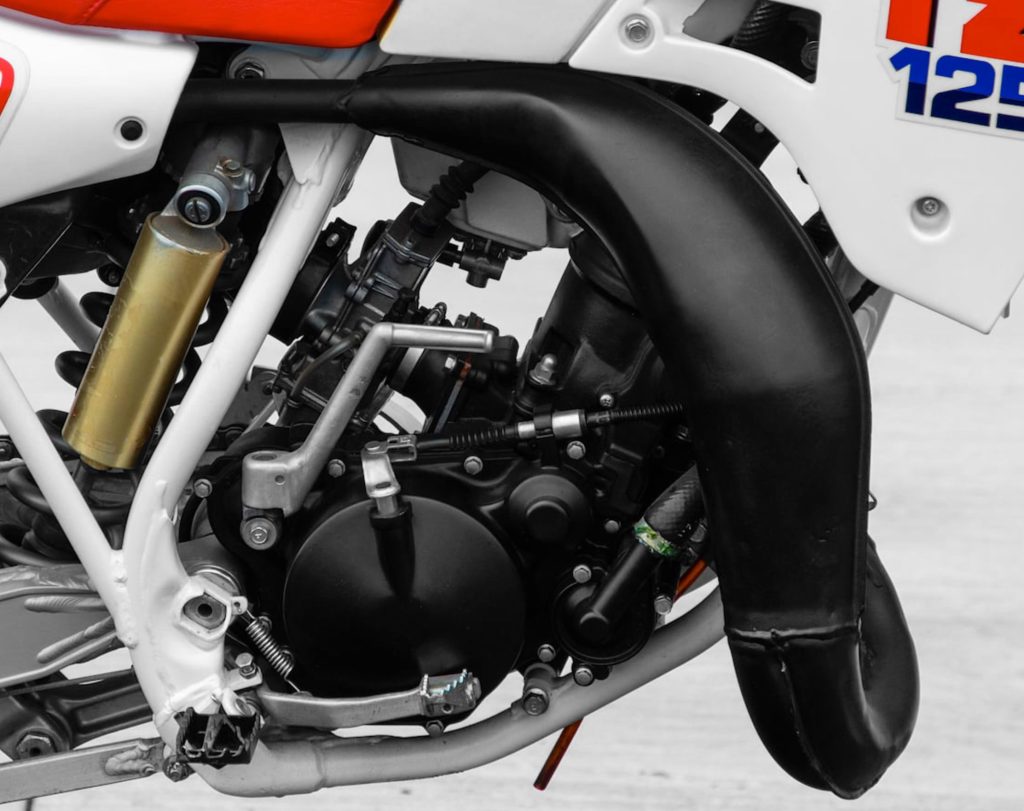 Changes made to the YZ’s 123cc case-reed mill for 1987 yielded a much-improved power package. Low-end torque was enhanced with the motor maintaining the strong blast of midrange power it had enjoyed the year before. Top-end pull remained lackluster, but the motor was extremely quick, fun to ride, and competitive. Photo Credit: Mecum
Changes made to the YZ’s 123cc case-reed mill for 1987 yielded a much-improved power package. Low-end torque was enhanced with the motor maintaining the strong blast of midrange power it had enjoyed the year before. Top-end pull remained lackluster, but the motor was extremely quick, fun to ride, and competitive. Photo Credit: Mecum
With its beefy low-to-mid burst, the YZ’s updated motor was very competitive. It was the exact opposite of Honda’s mid-and-up powerband but both machines were plenty fast enough to win in the right hands. The YZ rocketed out of tight corners and pulled a lead while other 125s were waiting to get going. There was loads of torque on tap and more than enough power available for most situations. As long as you timed your shifts well and did not try to ride it on the rev limiter, the YZ’s motor was fun and more than capable of winning.
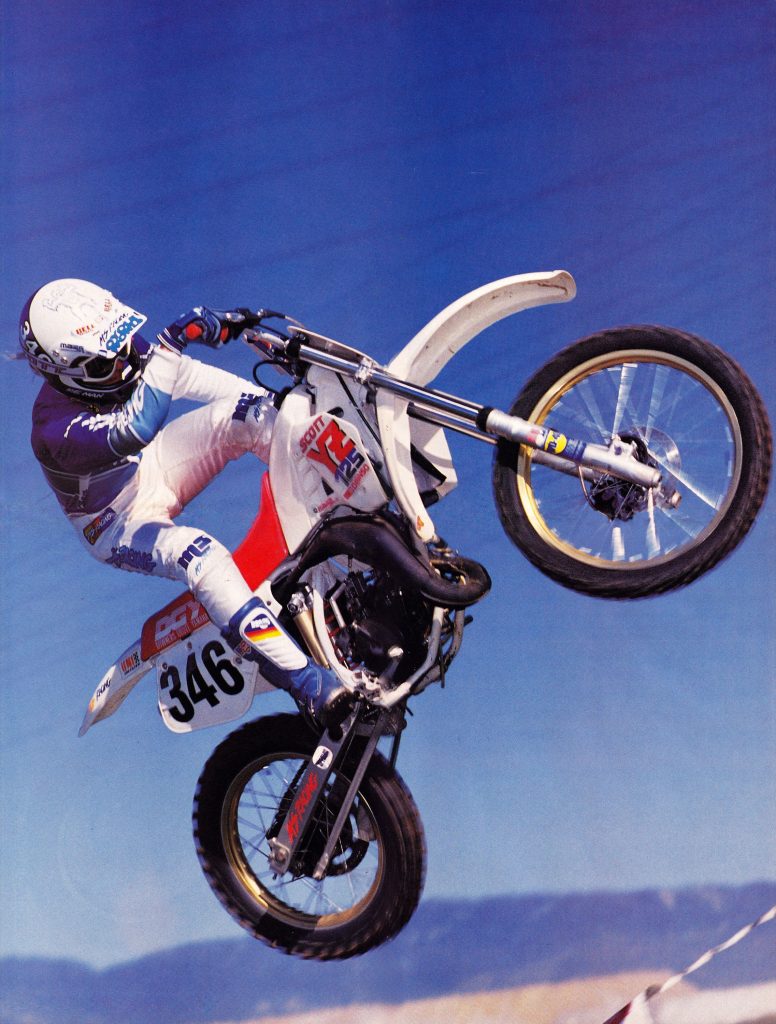 Despite being the heaviest bike in the class, the YZ’s explosive power and great ergonomics made it feel like one of the lightest. Big air and radical moves were a piece of cake on the Why-Zed in 1987. Photo Credit: Kenney Jones
Despite being the heaviest bike in the class, the YZ’s explosive power and great ergonomics made it feel like one of the lightest. Big air and radical moves were a piece of cake on the Why-Zed in 1987. Photo Credit: Kenney Jones
On the handling front, the YZ remained a middle-of-the-road package that favored high-speed stability over turning prowess. At speed, the white tiddler was an absolute freight train with none of the twitchiness that gave Honda riders night sweats. The YZ could be trusted to stay on its appointed path regardless of the track or conditions. In the turns, the YZ was far less predictable with a light front end that was difficult to trust at times. The combination of the YZ’s layout, geometry, and strong low-end tended to loft the front end under power and this made it a challenge to corner smoothly. Skilled riders learned to ride with a strong forward bias and feed in the power smoothly, but less-skilled pilots struggled with the YZ’s tendency to wheelie out of turns. If you could keep the front end planted the YZ was a decent turning bike, but its front end never provided the secure feel of Honda’s corner-shredding CR125.
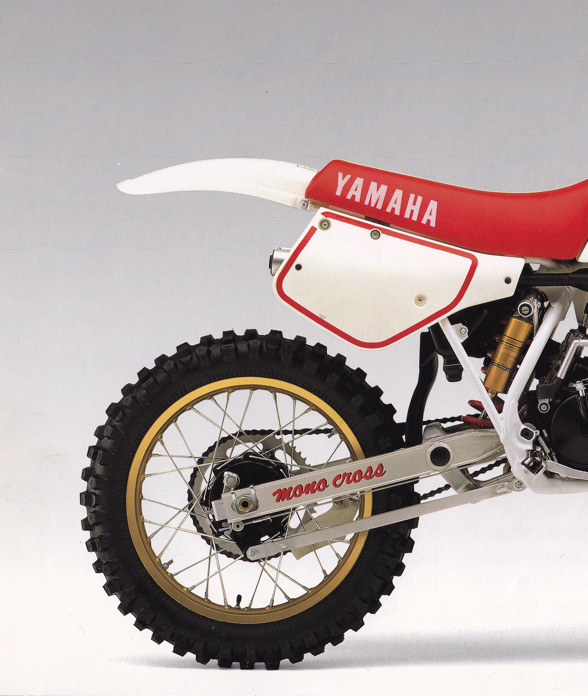 The YZ’s rear end was more effective than its forks but neither end was particularly efficient at smoothing out the track. Busy and choppy, the Mono Cross was raceable but less than comfortable. Photo Credit: Yamaha
The YZ’s rear end was more effective than its forks but neither end was particularly efficient at smoothing out the track. Busy and choppy, the Mono Cross was raceable but less than comfortable. Photo Credit: Yamaha
Jumping the YZ was a lot of fun with its strong motor and slim layout making airtime a breeze. Some care had to be taken not to grab too much throttle on takeoff, but the bike made quick work of jumps with short runs that were tricky on most other 125s. At 199 pounds, the YZ was the heaviest bike in the class, but its snappy motor and great ergonomics made it feel like one of the lightest. The light front end could be a bit tricky, but the bike flew straight and was easy to toss around. Overall, it was a fun bike to jump and a willing Supercross partner.
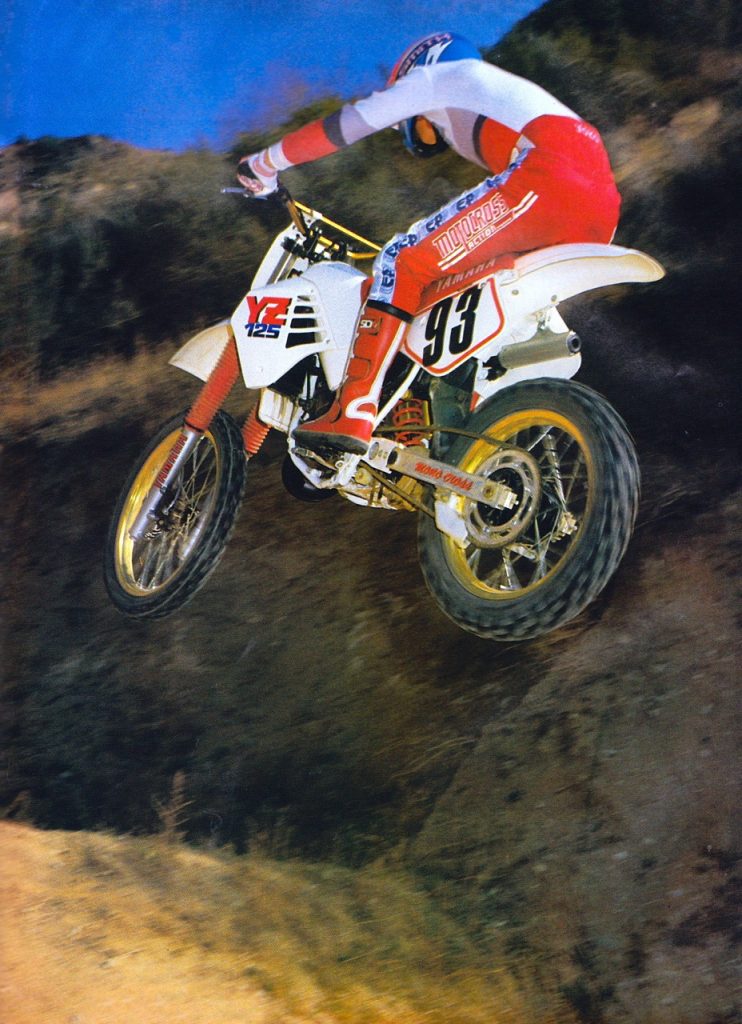 With its potent low-to-mid blast the YZ125 made quick work of tricky doubles. Photo Credit: Motocross Action
With its potent low-to-mid blast the YZ125 made quick work of tricky doubles. Photo Credit: Motocross Action
Of all the changes made to the YZ125 in 1987, the most disappointing updates turned out to be on the suspension. The decision to cheap out on the forks proved a major handicap to an otherwise competitive package. The new Variable Damping forks were supposed to provide smoother damping performance and reduced bottoming through the use of a new damper rod with compression holes that were controlled by an inner spring-activated piston. When the load on the fork was too great, the piston was designed to shut off the compression holes to increase resistance. While this did reduce bottoming, it also delivered by far the harshest ride in the class. Bottoming on hard hits was not an issue, but the new VD forks beat you to death on everything else. There was a huge spike in damping mid-stroke and the forks felt like they hydraulic locked on anything bigger than a gum wrapper. Braking bumps and small whoops pounded the rider’s wrists and even pros found the fork’s ride unacceptable.
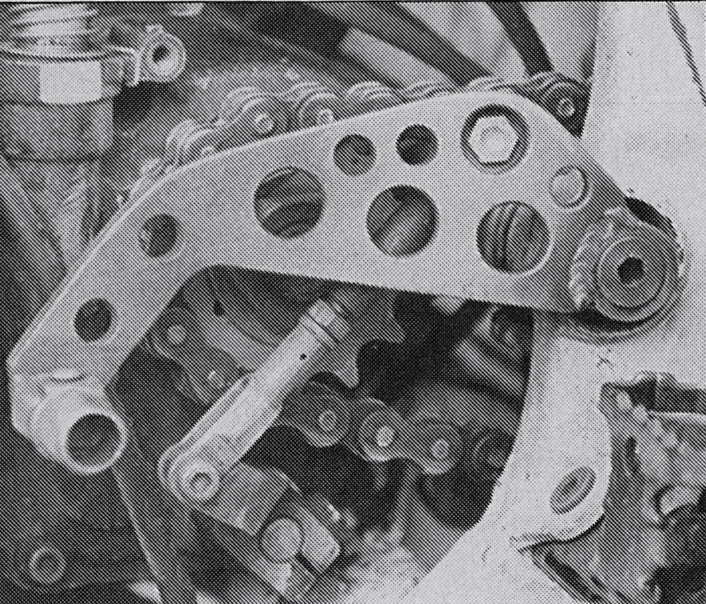 The Achilles heel of Yamaha’s ’87 powertrain was its stubborn stock transmission. Thankfully, Race Tech had an answer with their accessory shifter that changed the leverage point of the shift mechanism to improve its action. Photo Credit: Motocross Action
The Achilles heel of Yamaha’s ’87 powertrain was its stubborn stock transmission. Thankfully, Race Tech had an answer with their accessory shifter that changed the leverage point of the shift mechanism to improve its action. Photo Credit: Motocross Action
In the rear, the KYB shock’s action was better than the forks but still far from ideal. The new linkage and improved bearings were designed to provide a smoother ride in the rough, but the new shock proved busy and harsh. Big hits were taken well and the YZ could be trusted to take a pounding in deep whoops, but its action on small chop and breaking bumps left something to be desired. Riders complained about the rear end dancing around and refusing to take a set in the rough. The BASS system proved no more effective than in the past and many riders disconnected it in an attempt to improve the shock’s performance. Fast guys had less of an issue with the shock’s harsh ride, but no one thought it was in the same league as Suzuki’s excellent Full Floater in 1987. Overall, the shock was raceable as long as plushness was not on your dance card.
 Yamaha’s chain sliders during this era were renowned for their durability and notorious for the “clackity clack” sound they generated. Photo Credit: Yamaha
Yamaha’s chain sliders during this era were renowned for their durability and notorious for the “clackity clack” sound they generated. Photo Credit: Yamaha
On the detailing front, the YZ was improved but far from a class leader in 1987. New grips for 1987 offered less palm chewing than in the past but most riders still preferred an aftermarket alternative. The bars were utter junk with a bend no one liked and a construction akin to hot butter. A few hard landings were all it took to bend them and replacing them also helped alleviate the notorious “Yamaha thumb” blister that would form on the rider’s throttle hand from the awkward bend of the bar. The levers were well shaped but they were easily bent and tended to snap in half if you tried to bend them back into shape. The lack of a removable clutch access cover was pretty standard in 1987, but the fact that the redesigned CR125R offered it made it seem like a missed opportunity for Yamaha.
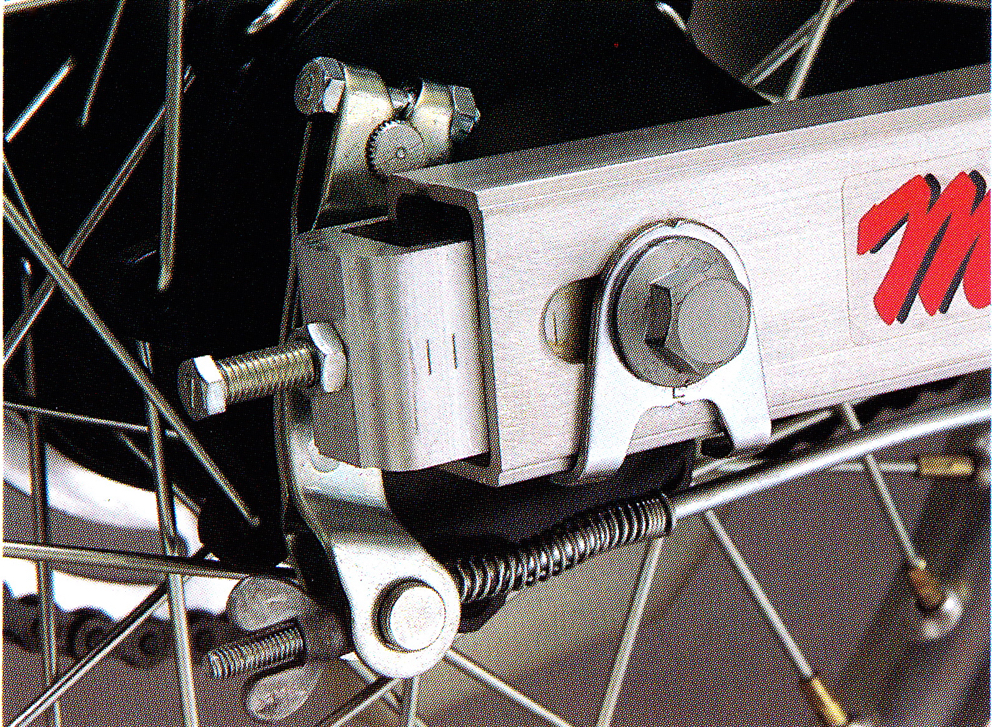 The YZ’s lack of a rear disc brake hindered its trickness quotient but did not really reduce its on-track effectiveness. Photo Credit: Yamaha
The YZ’s lack of a rear disc brake hindered its trickness quotient but did not really reduce its on-track effectiveness. Photo Credit: Yamaha
Overall braking was adequate for the bike’s power and weight, but the Honda and Kawasaki’s rear discs gave them an advantage if traction was plentiful. At the time, not everyone was a fan of the “right now” power the discs provided so the rear drum was not a serious handicap in the minds of some. That said, the discs were more powerful, more dependable in varied conditions, and certainly more trick.
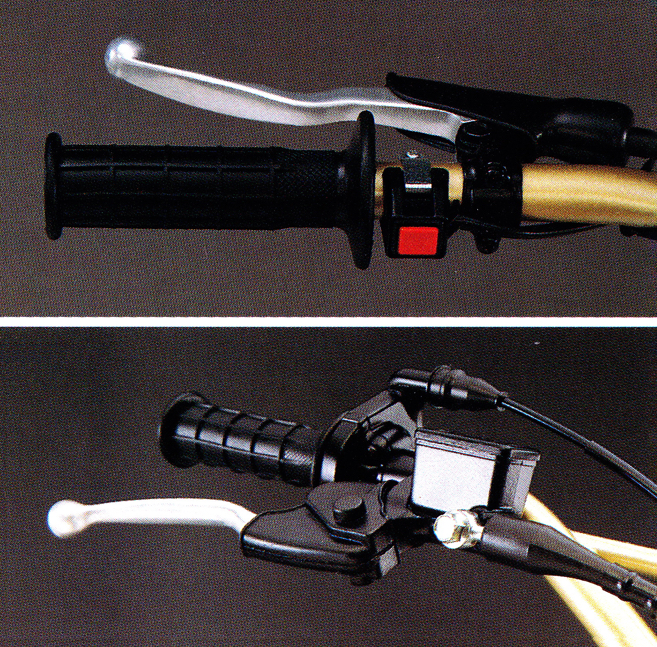 New grips for ’87 offered an improved feel, but the stock bars remained flimsy and unloved. Photo Credit: Yamaha
New grips for ’87 offered an improved feel, but the stock bars remained flimsy and unloved. Photo Credit: Yamaha
Plastic quality and fitment were good and most everyone liked the YZ’s slim layout and comfortable seat. Less liked was Yamaha’s affection for using Phillips screws instead of 8mm bolts throughout the YZ construction. These pot-medal fasteners were prone to packing with dirt and easily stripped. Chain and sprocket life were on par with that of the butter bars, but the chain slider was hard enough to cut diamonds. While this meant it was likely to never need replacing, its rock-hard construction led to a chain clatter that could often be heard over the motor. Overall motor reliability was very good with the new clutch proving much more robust than the year before. Some care had to be taken to ensure that the YPVS was adjusted properly but overall, the YZs proved mostly trouble-free.
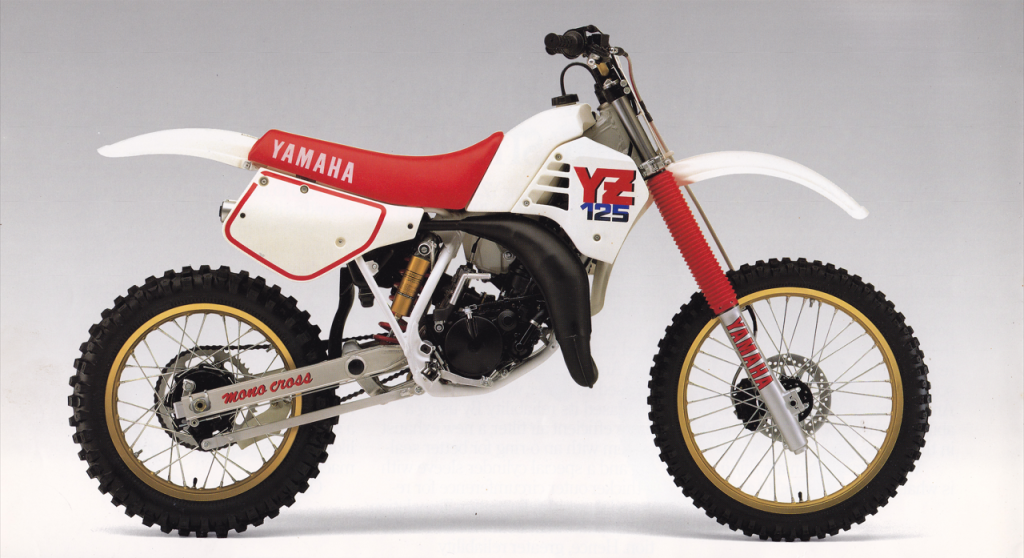 Yamaha’s YZ125 was a fun but flawed competitor in 1987. Photo Credit: Yamaha
Yamaha’s YZ125 was a fun but flawed competitor in 1987. Photo Credit: Yamaha
In the end, the 1987 Yamaha YZ125 turned out to be a unique machine with tons of potential that was undone by its cranky transmission and grim forks. The YZ’s torquey motor was fast and fun, providing the YZ with a very distinct personality. It barked out of turns and blasted around the track in a way that was wholly different than any other machine in the class. Unfortunately, Yamaha’s decision to save a few dollars on the forks torpedoed an otherwise competitive 125 package. In stock condition, the YZ125 had the firepower to run at the front, but it was a shifter and fork away from taking the crown away from its rivals in 1987.




